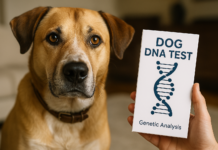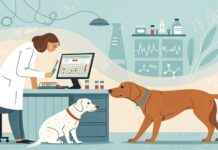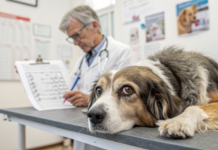Last Updated on September 18, 2022 by Dogs Vets
Your dog can benefit from laser treatment
Being a pet parent is not easy. You can feel the pain of the ones who cannot speak for themselves.
The most challenging thing for them is to choose what we should do to take away their pain. Well, do not worry; we have got your back.
Laser therapy is an innovative, pain-free and pill-free technique to reduce your pet’s pain without intervention into the body.
Although laser therapy for canines has been around for quite sometime, there has only lately been evidence to support its utility in reducing pain and quickening the healing process.
The use of a therapeutic laser to treat various illnesses has attracted a lot of attention as more research has been conducted.
How is laser treatment better for my pet friend?
Your dog can benefit greatly from laser treatments for pain management.
Laser treatment drains swollen regions by stimulating the lymphatic drainage system and lowering inflammation through the opening of blood vessels. As a result, there is a decrease in swelling and discomfort.
Additionally, the lasers activate nerve cells that lessen nerve sensitivity by preventing the brain from receiving pain signals. The dog will feel lesser pain since there is less edema, reduced inflammation, and disruption of pain signals to the brain.
Additionally, significant quantities of naturally occurring endorphins are stimulated during laser therapy for dogs, which further reduces pain.
What are the benefits of laser therapy?
Dogs with cellulitis, osteoarthritis, and other illnesses can benefit from therapeutic laser treatment. Despite being most frequently used to treat musculoskeletal pain, laser therapy can also:
- Healing of surgical wounds
- Healing of traumatic wounds
- Boost the metabolism of specific tissues
- lessen the development of scar tissue
- Enhance nerve regeneration and function
- Easing of uncomfortable trigger points
Laser treatment helps the body’s numerous tissues, including the skin, ears, gums, muscles, and tendons, recover by reducing pain and inflammation.
What are the conditions my dog can get benefit from laser therapy?
Numerous conditions can be treated using dog laser treatment, including:
- Injury to muscles, ligaments, and tendons
- Surgical aftereffects and soft tissue injury
- Backache
- Inflammation
- Infected ears
- Gingivitis
- Open wounds and hot spots
- Skin conditions
- Osteoarthritis
- Joint pain and hip dysplasia
- Dystrophic disc disease
- Anal swollen glands
The pain and inflammation brought on by these chronic illnesses can be treated with cold laser therapy in dogs. After multiple therapy sessions, several dogs who could scarcely walk before treatment can now walk and move considerably better.
It is wonderful to observe how much their quality of life has increased and how significantly the number of prescribed prescriptions has decreased!
What distinguishes cold laser treatment from surgical lasers?
Cold laser therapy, as the name indicates, has a specific wavelength of light (packets of energy) which can penetrate the body tissue without damaging it like surgical lasers.
Surgical lasers have a high wavelength that damages the tissue and is used with specific caution by the surgeon only in surgery.
Cold laser therapy is cold in nature, does not cause excessive heat, and can be used by anyone. It only works on the body’s healing mechanism and produces abundant ATP in mitochondria.
How are laser procedures carried out?
The portable laser wand is slowly rubbed back and forth over the injured tissue during a treatment session, creating a warm, pleasant sensation that most animals appear to like and find restful.
The number of sessions for therapy and frequency of treatments depends on the injury and often last 15 to 30 minutes. While open wounds and surgical incisions frequently need daily care, chronic illnesses may only require weekly therapy.
This therapy is far gentler than other conventional treatments that could be highly invasive on the body, including surgery.
Imagine your dog or cat is just sleeping or sitting comfortably on a comfortable bed while a nurse or veterinarian points the laser beam at the necessary location. Quite a relief!
How many laser therapy sessions will be necessary for your dog?
Depending on the laser utilized, the ailment being treated, and whether it is a chronic or acute problem, the frequency of dog laser therapy sessions varies.
Depending on the results, two to three times a week for two to three weeks before reducing the frequency is good enough.
Is cold laser therapy safe for my pet friend?
No, there are no hazards or negative consequences. There are a few circumstances where we wouldn’t advise laser treatment, particularly concerning issues like mass deletions or similar problems. But aside from that, it is entirely safe if we use it properly.
Laser therapy is safe when used properly, with the appropriate settings and treatment intervals. Inappropriate usage of higher-powered devices might result in heat burns to tissues.
Additionally, clients and veterinary workers must wear protective goggles throughout treatment since laser pulses pointed at the eye might result in long-term retinal damage.
Facts Check:
We hope you enjoyed this article… What are your thoughts?
Рleаse feel free to share with us in the comments section below!

















